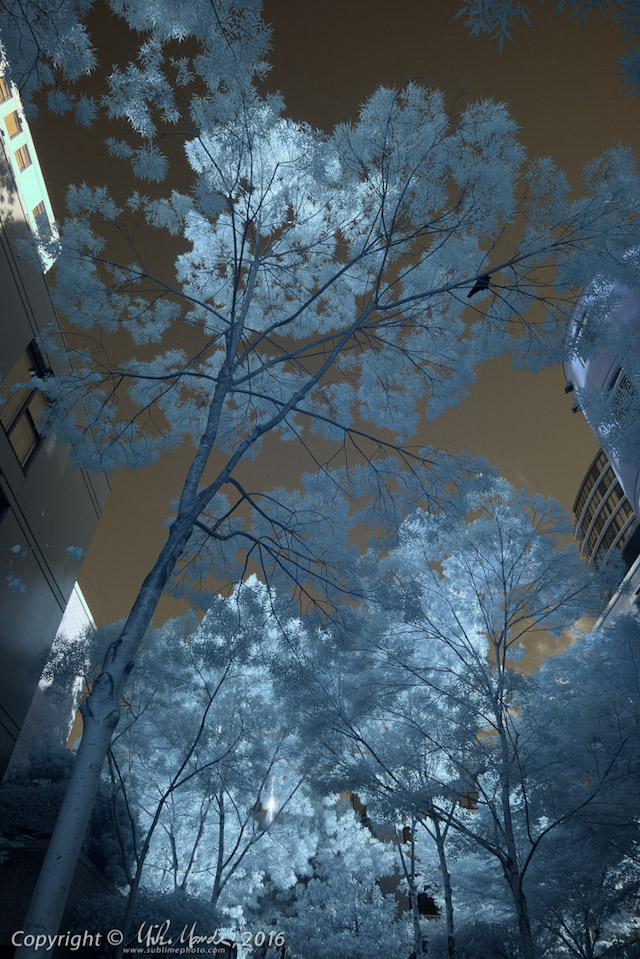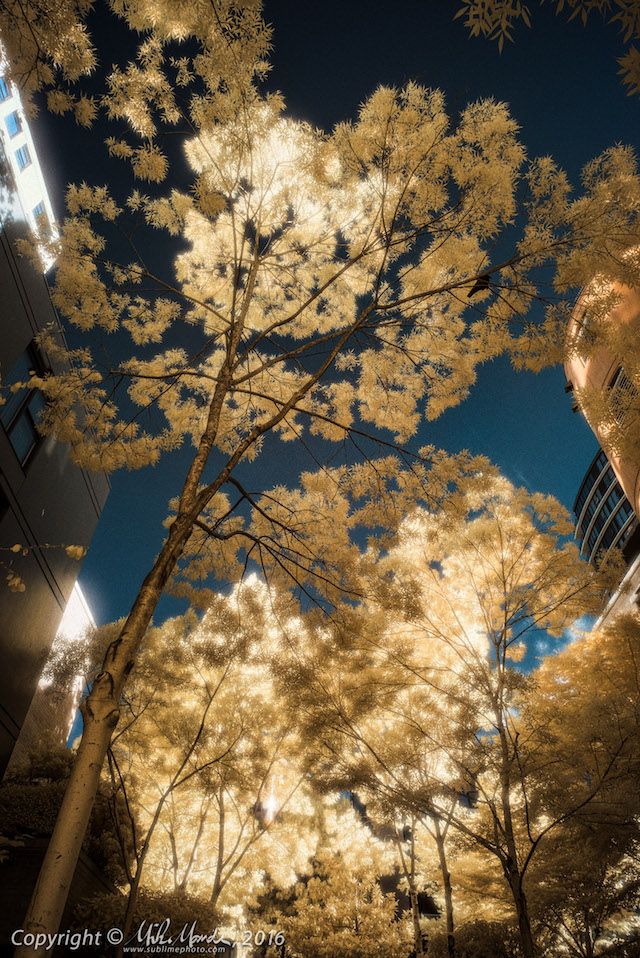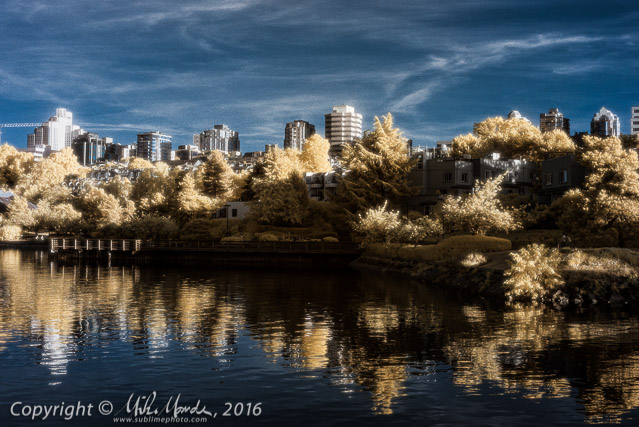Gallery (30 images): Infrared modified Fujifilm X-E2
Over the years I've had several digital cameras dedicated to IR photography, first starting back in 2000 (if memory serves) with a Nikon Coolpix 800, then followed by an Olympus C4040 and then a Nikon Coolpix 5400. With those cameras, I used deep IR filters on otherwise stock cameras and shutter speeds were long enough in full sunlight, that I often had to use a tripod. I never used those cameras for colour photography since I felt that their image quality wasn't good enough, however with the IR grain and glow added in post, they seemed to mostly suffice for my B&W IR ambitions. Back then, I was shooting medium format transparency film with a Pentax 67II, my main camera at the time.
Then, after buying a Canon EOS-30D in 2006, I decided to have my very first digital SLR that I had bought in 2004, an EOS-20D, converted to a dedicated IR camera, letting LifePixel do the modification with a standard 720nm bandpass IR filter. I had that camera for many years, finally selling it when I started to use Panasonic Micro-4/3 bodies. In 2012, when I was shooting with a GH2, I decided to buy a Panasonic GF2 body and immediately had it converted to shoot IR (720nm as well), and used LifePixel once again. With a standard DSLR, one has to worry that IR light doesn't focus in the same plane as visible light, leading to focus errors when the visible light is used either by the DSLR's AF sensor, or by you if manually focusing via the camera's focusing screen. This is why many older lenses had an IR offset dot on their focusing scale, so you could manually shift the focus to compensate. Well, with a mirrorless camera like the GF2, the main image sensor is being used to focus, and since the IR filter is, of course, in front of the image sensor, you get perfectly accurate AF, as well as being able to see the IR effect through the EVF or back LCD screen. Overall, this made shooting IR much more pleasant and accurate compared to a modified DLSR!
However, I never ended up using the modified GF2 all that much, mainly because many of my Panasonic lenses performed quite poorly in IR light, exhibiting very soft edges and corners, lots of lens flare, and some also had IR "hotspots" where you would get a bright circle in the centre of the frame as soon as the lens was stopped down a bit. My Canon lenses, despite being more of a hassle to use, had performed better overall in IR light if compared to those Panasonic lenses. In addition, the sensor in the GF2 would sometimes exhibit banding and other weird artifacts, once a shot was post-processed to crank up the contrast. It wasn't really too bad, but that, along with the many lens issues, were just annoying enough that a rarely opted to use it.
So at the end of last year, since I wasn't really shooting with it much, I decided to sell my converted GF2 as well as the last of my Panasonic and Olympus lenses. The GH2 had been sold a while back, as well as the Panasonic GX1 and GX7 bodies, and most of the Micro-4/3 lenses that I had owned. Now that I am shooting 100% with a Fujifilm system (no more DSLR either), I was waiting for the right time to have a body converted. I had researched shooting IR with Fujifilm lenses online a bit, and generally, many of the lenses were said to perform extremely well. So... when I bought my X-Pro2, I had two X-E2 bodies on hand, one to be used as a backup camera, but the second one I had kept in anticipation of its eventual IR conversion. When LifePixel had a 15% off sale some weeks back, I finally decided to go for it, and sent one of my X-E2 bodies in, ordering the "Enhanced IR" filter conversion, a slightly "lighter" 665nm bandpass IR filter that what I had been used to before.
I had studied the examples that LifePixel has on their site, and decided it might be nice to have a bit more colour info in my captured IR raws, in order to let me create more interesting colour IR photos, or so I had hoped. In addition, the deep IR contrast didn't seem too toned down; water and skies were still nice and dark, and sunlit foliage was still nice and bright. What little loss in overall IR contrast there was, I felt I could easily recover in post processing. Well, I'm sure glad I chose that filter since the post-processing colour results are far more interesting than what I had been used to with my previous cameras!

665nm IR modified X-E2 - raw from Lightroom
The above image shows how a raw file from the modified camera looks when brought into Adobe Lightroom. This is about as "neutral" as one can get, with the WB colour-temperature slider fully to the left. As I have stated before, I prefer using PhotoNinja, so below is the same shot processed in PhotoNinja. You can see that it has more latitude for adjusting the wacky colour than Lightroom has...

665nm IR modified X-E2 - raw from PhotoNinja
I find that neutralizing the shot a bit more in PhotoNinja seems to make additional post processing a bit easier. That said, there are still a lot of things I want to try and since my time with this camera has been brief so far, I may find that other types of processing will also yield good results, maybe even better than what I am getting so far...

665nm IR modified X-E2 - after processing in Photoshop
The PhotoNinja converted shot then gets brought into Photoshop for a red / blue channel swap. I then use a complicated series of actions that I've created over years of working with digital IR, where I add glow around the brightest sunlit highlights, attempting to mimic the "halation glow" than one used to get with the classic Kodak HIE infrared film emulsion. I also add grain in a complex action, where shadows, mid-tones and highlights all get differing amounts and types of grain. The above photo is a result of that processing. From there it's back into Lightroom...

665nm IR modified X-E2 - after final processing in Lightroom
So, how do the Fujifilm lenses perform? Well generally they are just as fantastic in IR light as they are in visible light, the exception being their resistance to flare. Generally speaking, even the best lens coatings don't seem to be all that good at preventing IR lens flare when the sun is in the frame, or shining on the front element. Below is one example, where the sun is just outside the frame to the upper right, but shining on the front element of my XF 23mm f/1.4...

665nm IR modified X-E2 - infrared lens flare example
It gets even worse if the sun is actually in the frame! In visible light, the 23mm would basically have been completely flare-free. However, flare issues were expected, and apart from those, my lenses are generally performing very well. None that I've tried seem to give up any corner sharpness at all when shot in IR, and most also do not exhibit IR hotspots. The primes are generally very good, with the 14mm f/2.8, 16mm f/1.4, 23mm f/1.4, 35mm f/2 and 90mm f/2 all being near flawless performers (apart from flare). My 60mm f/2.4 macro does show a bit of an IR hot-spot when stopped down to f/8 or beyond, but it's fine at wider f-stops. There might be a very slight, diffuse IR hotspot with my 16mm beyond f/8, but I am not yet sure if what I've seen in a handful of shots is actually that. I have yet to test any of my zooms, but I have heard that the 18-55mm f/2.8-4 kit lens is a poor performer as far as having a serious IR hotspot at almost all apertures. The 10-24mm f/4 is supposed to be bad as well, but the 55-200mm is apparently good if kept at an aperture that's wider than f/8.
I will likely publish a more detailed, dedicated IR Fujifilm lens test review in the future, but for now I can say that I am generally extremely happy with my Fujifilm prime lenses when used with IR light. The overall image quality that I'm getting from my converted X-E2 is far better than from any of my previous IR cameras. I think I'm going to have a lot of fun with this one...



0 comments:
Post a Comment